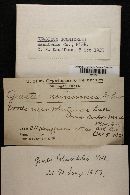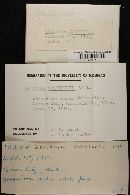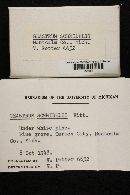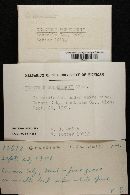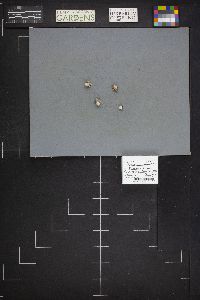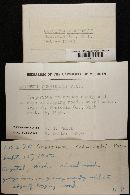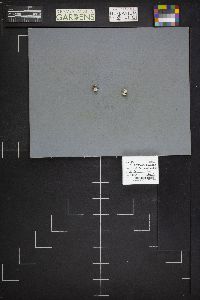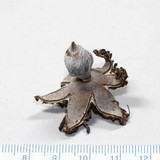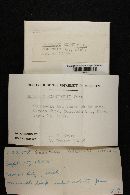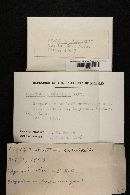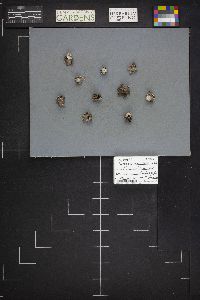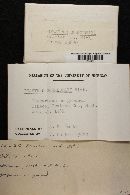
|
|
|
|
Family: Geastraceae
[Geastrum schmidelii var. coniferarum (V.J. Staněk) Lécuru, morePlecostoma nanus (Pers.) Desv., Plecostoma schmidelii Desv.] |
Sunhede S. 1989. Geastraceae (Basidiomycotina): Morphology, Ecology, and Systematics with Special Emphasis on the North European Species. Synopsis Fungorum, 1. Oslo, Norway: Fungiflora Geastrum schmidelii Vittadini Monog. Lycoperd. 13-15, 1842 (as Geaster). Mature fruitbody mostly small. Exoperidium nonhygroscopic, arched in expanded state, mostly splitting into 6-9 rays. Endoperidial body short-stalked. Endoperidium smooth. Peristome plicate, mostly ± well delimited. Unexpanded fruitbody: Young fruitbodies just prior to opening hypogeous, about 7-30 mm wide, ± globose to depressed globose. depressed or ± broadly ovate (cf. fig. 178A), sometimes with a small umbo at the top (fig. 178A:d), with or without a basal mycelia] tuft. Mycelial layer mostly strongly encrusting debris and sand (cf. fig. 178A:a). Expanded fruitbody: Very small to medium-sized species (tab. 2; fig. 180A). Exoperidium splitting from less to more than the middle into 5-12, mostly 6-9 rays of varying shape (figs. 178B:a-e; 179A,B). The position of the rays varies from ± horizontal to ± vertical (fig. 178B:a,d,e), more rarely they are recurved under the exoperidial disc as in fig. 179B:e. The exoperidium is not truly hygroscopic but sometimes dry fruitbodies are found with the rays rolled or bent towards the endoperidial body (fig. 178B:b.c). Exoperidium ± arched (figs. 177A,B; 178B:a-e; 179B:e). The diameter of the exoperidium varies between 7 and 51 mm (in specimens with horizontally mounted exoperidia 16-80 mm). Pseudoparenchymatous layer when fresh about 1-2(-3) mm thick, at first whitish (cf. fig. 177D) in age turning beige, light brown to dark brown, in old specimens almost blackish brown, as dry with the following colours observed: pale greyish beige, ± ochraceous, light brown to dark brown, brownish grey and blackish brown; rather persistent and often remaining ± intact or at least as remnants in over-wintered fruitbodies. Fibrous layer when totally denuded ± papery; outer side in dried specimens, collected as ± fresh, whitish beige, beige or brownish beige; in old specimens whitish to dirty white. Mycelial layer encrusting debris and sand, mostly intact in newly expanded specimens and often ± intact even in over-wintered fruitbodies. Endoperidial body stalked, very variable in shape, globose to depressed globose, ± ovoid to obovoid, ± pyriform, ellipsoid (in vertical section) or even ± irregularly shaped (cf. figs. 177A-D; 178A:a-c,B; 179B; 180A; 181). Diameter 3.5-20.5 mm but often 5-10 mm (tab. 2; figs. 179A; cf. 180A). Apophysis present or absent (figs. 180A; 181), sometimes ± striated as it may be in G. pectinatum (figs. 180A:f), concolourous with, darker or lighter than the rest of the endoperidial wall. Stalk mostly 1-3 mm high (see Discussion). rounded to flat in cross section (fig. 180B:d). whitish, beige or rather pale brown, in old over-wintered specimens dirty white, or greenish due to algae. Endoperidium ± smooth, often greyish brown or brownish grey (see Discussion), with no endoperidial cover or with a faint crystalline pruina in newly expanded fruitbodies (fig. 184A-C). Peristome plicate, ± narrowly to broadly conical, sometimes mammiform or almost flat (figs. 177A-D; 180A,B:a-c; 181), mostly with 11-26 folds (cf. fig. 180B:e-h). Microscopy: Basidia with a basal clamp connection or narrowing into a hyphal part ending at a clamp. When young rounded. ellpsoid or clavate (figs. 182a: 183a-d,f), sometimes of other shapes or with a lateral protuberance (fig. 183e.i-k). Mature or almost mature basidia of the same shape as the young ones, with a broad apical bulge or gradually somewhat narrowing towards the top (fig. 182a-m) apart from hyphal part. 11-18 x 4.5-8(- 10) µm, hyphal part. Geaster schmideli Vittad.: Vittadini, C. 1842. Monographia Lycoperdineorum: 13 (Table I, Figure VII).
Cortex peridii in lacinias subaequales ad medium fissus, strato intetiori crasso, evanescenti instructus. Capitilum pedicellatum. Peridium papyraceum ore determinato, conico-acuto, plicato-sulcato. Columella brevis, subcylindrica.
|






